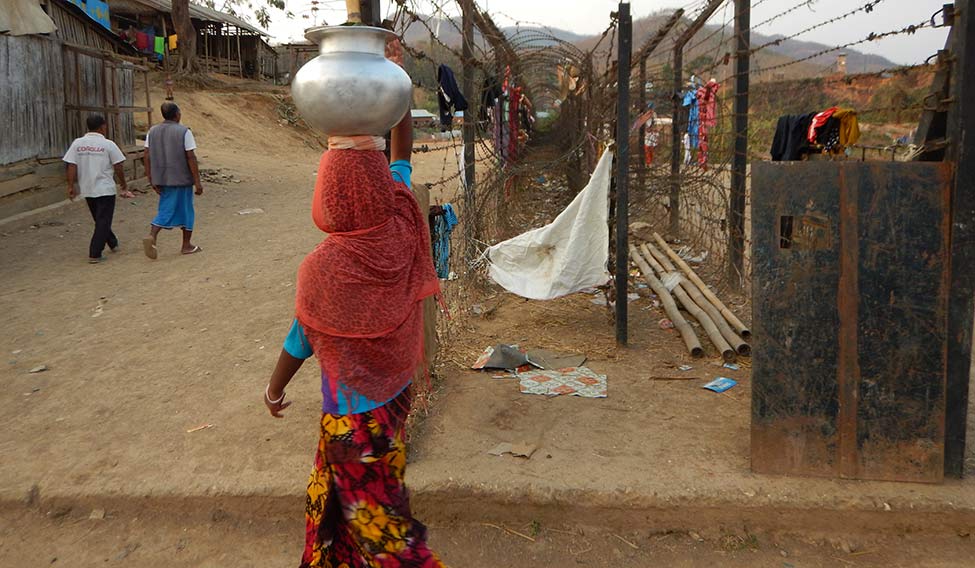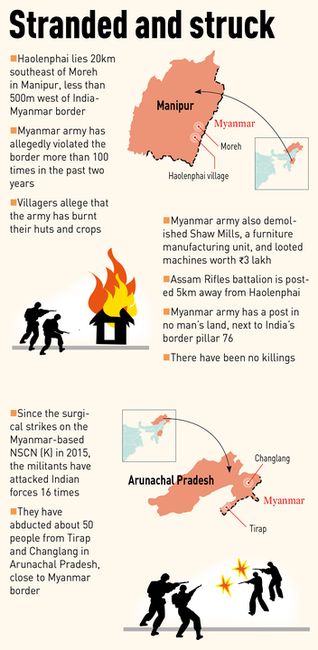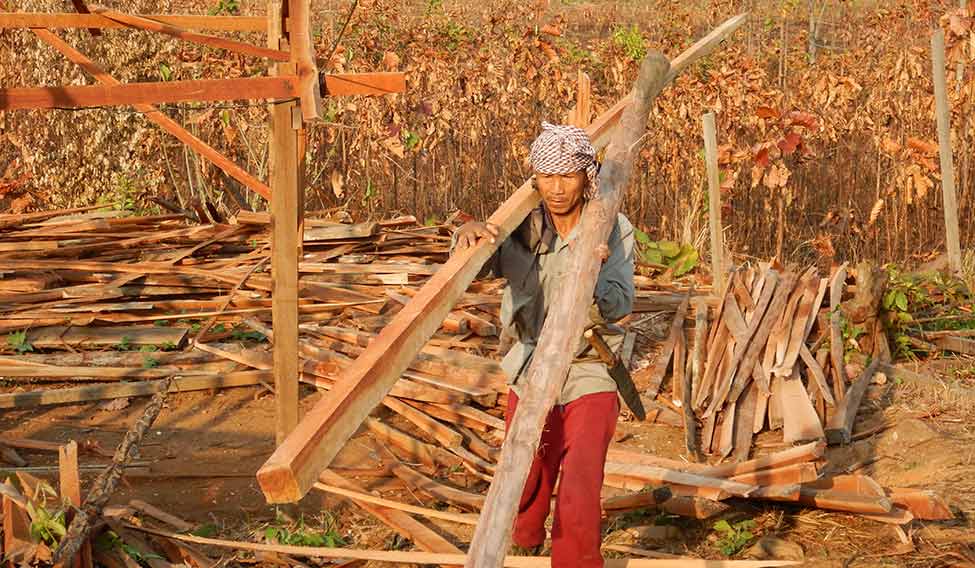Twenty kilometres southwest of Moreh in Manipur’s Tengnoupal district, a trading hub near the India-Myanmar border, lies Haolenphai, a scenic village surrounded by hills and inhabited mostly by people from the Kuki tribe. Less than half a kilometre east of Haolenphai is the international border. A pillar (number 76, according to the Union home ministry) demarcates India’s territory from the no man’s land to the east. Further east is Myanmarese territory.
Despite the clearly demarcated border, residents of Haolenphai say they are perilously close to Myanmar. The border outpost of Assam Rifles is 5km west of Haolenphai, which means the village has little defence against attacks from the Myanmar side. In the past two years, say villagers, such attacks have increased.
They say the Myanmarese army has moved closer to Haolenphai, installing its border outpost less than a kilometre from the village. It means that the outpost is now on no man’s land. For the past four months, allege the villagers, the army has been crossing the border, robbing them and setting their huts and crops on fire, sometimes even in broad daylight.
Apparently, the trigger was the Indian government’s decision to develop Haolenphai and adjoining areas as part of the Union government’s mission to build 100 smart cities across India. The decision came in 2014, when the Congress was in power in Manipur. Okram Ibobi Singh, then chief minister, requested the prime minister to build the smart city covering an area encompassing Moreh and Haolenphai.
What the Central and state governments did not take into consideration then was the fact that Myanmar had for long claimed Haolenphai as part of their territory. Soon after it was announced that the village would become part of a smart city, the Myanmarese army became very active, violating the border more than 100 times in the past two years.
The “torture”, as villagers call the continuing attacks, has destroyed their property and livelihoods. Last month alone, 20 houses were burned down by people dressed as Myanmarese soldiers. They also allegedly demolished Shaw Mills, a furniture manufacturing unit in the village, and stole machines worth Rs 3 lakh.
 Life at risk: A villager returns to Haolenphai after the crossing the border in search of water; the Indian Army has stopped erecting fences around the village because of resistance from the Myanmar side.
Life at risk: A villager returns to Haolenphai after the crossing the border in search of water; the Indian Army has stopped erecting fences around the village because of resistance from the Myanmar side.
“People dressed in army uniform raid our village at daytime,” said Lal Kholun Haokip, the village chief. “They hold us at gunpoint, ask us to get out of our houses and then light them up. They destroy crops and ask us to go away from the village, saying the land belonged to them. We are helpless.”
The only silver lining, according to him, is that there has been no loss of life. When THE WEEK visited Haolenphai recently, many villagers were gathering timber to rebuild their houses. But, with attackers having started to burn down plantations as well (including those that grow the famed Burma teak), even timber has become precious.
According to Lal Kholun, the cross-border attacks increased after India carried out a surgical strike on the outpost of the Khaplang faction of the National Socialist Council of Nagaland [NSCN(K)], an armed insurgent group based in Myanmar, in 2015. “Earlier, they [the Myanmarese army] used to send messages to us that we need to vacate the villages,” he said. “They would also raid our houses occasionally. But, since 2015, there have been more than 100 attacks. Villagers rebuild their houses and they are again destroyed. In this part of the world, earning a living is so difficult. How would they continue to rebuild their houses? The government is not helping us.”
In March this year, the BJP came to power in the state. But, the situation in Haolenphai remains unchanged. Angry at not being provided security despite their repeated complaints, the villagers say they are now planning to take up arms to defend themselves. “We are scared of the Myanmar army bombing our village and setting our huts on fire,” said Laonip Haokip, a farmer whose house and crop were destroyed. “Our women and children are not safe. But, the new government of Manipur is keeping mum.”
The villagers allege that the government is turning a blind eye to their suffering to maintain friendly ties with Myanmar. Apparently, India has decided not to engage in an open border dispute, keeping in mind the turbulent political situation in Myanmar.
“A year ago, Assam Rifles caught three Myanmar army officers red-handed,” said Lal Kholun. “They were kept in the Assam Rifles outpost in Moreh. But the Myanmar government struck a deal with the Indian government and Assam Rifles was forced to release the three officers.”
What India cannot ignore is that, with the villagers threatening to take up arms, the situation in Haolenphai is now on the verge of reaching a flashpoint. The Indian Army has stopped erecting fences around the village, because of resistance from the Myanmar side.
“Haolenphai is part of India. We have told them this categorically,” Kh Raghumani Singh, deputy commissioner of Tengnoupal district, told THE WEEK. “It is because of their resistance that the fencing could not be erected there. But, they would not be able to hold us back. We will complete the fencing in a year or two.”

Assam Rifles refused to comment on why the fencing has been stopped. “That matter is confidential and sensitive,” said a senior officer. “The operation front of Assam Rifles comes directly under the Indian Army. So, the defence ministry or the Army would be the right authority to talk about the issue.”
When THE WEEK contacted Fort William, the headquarters of the Army’s eastern command, the spokesperson there refused to elaborate on the matter. “It must have been taken up by higher authorities in Delhi,” said the spokesperson. “We are waiting for their response.”
THE WEEK learnt that Assam Rifles briefed Vikram Misri, India’s ambassador to Myanmar, who recently visited northeastern states to assess the border situation. Raghumani Singh said Misri was briefed about the “Haolenphai crisis”. “We requested him to take up the matter with the Myanmar government, so that their army stops this forever,” he said.
According to him, the matter has been taken up by the external affairs ministry. “A team from the MEA visited Haolenphai and they took stock of the situation,” Singh told THE WEEK. “I also accompanied them. We have learned that the MEA has already taken up the matter with the Myanmar government.”
When THE WEEK contacted Yangon, a foreign ministry official said, “We have no doubt that there is an issue on the border with India. But we will not make any media statement unless we are advised by our ambassador’s office in India.”
THE WEEK contacted U.E. Aung, second secretary at the Myanmar high commission, who asked for a detailed query in writing regarding the matter. But, when the query was submitted, the high commission decided not to comment. “After careful consideration, we have decided not to make any comment over the issue at this moment,” Aung told THE WEEK.
Haolenphai is not the only place on the India-Myanmar border where the situation is tense. The NSCN(K), allegedly at the instigation of a section of the Myanmar army, is making incursions into Tirap and Changlang districts in Arunachal Pradesh. “The government has been talking to the NSCN(IM) [the Isak-Muivah faction] and it has been restrained,” said Tesam Pongte, member of the BJP, which is in power in Arunachal Pradesh, and legislator from Changlang North, which borders Myanmar and is known to be a den of NSCN(K) militants. “But, to restrain the NSCN(K), the government has to talk to the Myanmar army through the new government there. I hope they are doing that now, because the NSCN(K) has been waging an open war against us.”
THE WEEK accessed a report prepared by the Union home ministry, which has details about the situation in Haolenphai. “There is no shift of the border pillar, 76, by Myanmar’s army,” said the report. “But keeping an eye on the law-and-order situation, it has been proposed that there should be a police post in [Haolenphai]. On the other side, both the Myanmar army and the Myanmar police are guarding the border. Around 60 people are stationed in Myanmar’s side.”
Officials told THE WEEK that the government has shelved the proposal to build the smart city. “We have decided to put that on hold,” said N. Indrajit Singh, parliamentary secretary at the urban development department. “We are now concentrating on Imphal to make it a smart city. The BJP-led government in Manipur is working steadfastly in this regard. We are acquiring land for it.”
What Singh did not comment on was the fact that the previous government had acquired 3,000 acres in and around Haolenphai to build infrastructure as part of the smart city project. A good number of villagers were rehabilitated and roads were built. But, then came the pause. And, quite unexpectedly, it came because of what the Myanmarese army has allegedly been doing.
Past the Assam Rifles outpost and on its way to Haolenphai, THE WEEK met an angry villager named Timpu Haokip. “What are you here for?” he asked. “Had this been Kashmir, we would have had our voices heard. You don’t know the number of sleepless nights we have had.”
Timpu led THE WEEK to an area where the remains of 20 houses gutted in fire could be seen. Surrounding the houses were charred remains of crops and big trees. “The Myanmarese army has destroyed everything,” said Paoboy Singson, a 30-year-old Kuki. “They have threatened to take our lives if we go and complain to the Indian Army. Deploying the police alone would not do. We need a full-fledged group of Assam Rifles in our area to take on the army of Myanmar.”
After dusk fell, Paoboy took THE WEEK to a spot near the international border and pointed to the other side. Right across the border, men who appeared to be Myanmarese army personnel were playing volleyball.
Near the court, a makeshift Buddhist temple and a solar power plant could be seen. The men were playing by floodlight. On the Indian side, Haolenphai lay dark and silent, as if fearful of the men across the border.







